Luxury Brands: Experiential’s New Mavericks of Storytelling

The scene was spellbinding: ice skating through the steam of a frozen pond, country animals out to pasture, even tightrope walking in a circus big top. This spectacle wasn't just another event, it was a master class in experiential marketing — without the marketing. Last summer, “On the Wings of Hermès” unfolded at Santa Monica’s Barker Hangar. Over eight days and 24 performances, this free, immersive production enchanted attendees. The show was born out of the Greek mythology of Pegasus, an immortal winged horse, and this newest chapter — crafted by the storied French luxury brand Hermès — revealed that Pegasus had seven foals, all seeking lightness so they might grow their wings and fly. Visitors were treated to seven distinct vignettes on meticulously crafted sets featuring a lofted screen. Live performances within these miniature stages were simultaneously filmed and projected overhead, blending the real with the virtual. Stagehands disappeared from the screen, turning the space into a front-row cinematic experience that transcended traditional boundaries through expert framing and theatrical illusions. “On the Wings of Hermès” epitomized brand storytelling, turning what could have been just another promotional event into a genuine artistic experience, engaging guests without the looming air of...


